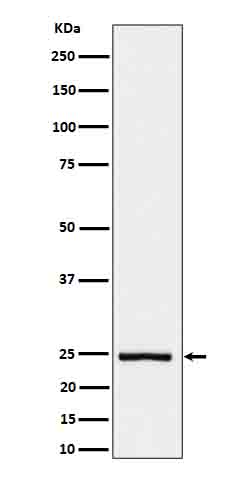
| WB | 咨询技术 | Human,Mouse,Rat |
| IF | 咨询技术 | Human,Mouse,Rat |
| IHC | 咨询技术 | Human,Mouse,Rat |
| ICC | 技术咨询 | Human,Mouse,Rat |
| FCM | 咨询技术 | Human,Mouse,Rat |
| Elisa | 咨询技术 | Human,Mouse,Rat |
| Aliases | IL26; Interleukin 26;;IL 26 |
| WB Predicted band size | Calculated MW: 20 kDa ; Observed MW: 40 kDa |
| Host/Isotype | Rabbit IgG |
| Antibody Type | Primary antibody |
| Storage | Store at 4°C short term. Aliquot and store at -20°C long term. Avoid freeze/thaw cycles. |
| Species Reactivity | Human |
| Immunogen | A synthesized peptide derived from human IL 26 |
| Formulation | Purified antibody in PBS with 0.05% sodium azide,0.05% BSA and 50% glycerol. |
+ +
以下是3篇与IL-26抗体相关的代表性文献(内容基于公开研究整理,建议通过学术数据库验证全文):
---
1. **文献名称**: *"IL-26 is overexpressed in rheumatoid arthritis and induces proinflammatory cytokine production in human macrophages"*
**作者**: Kim, H. et al.
**摘要**: 研究发现IL-26在类风湿性关节炎患者的滑膜组织中高表达,并证明其通过激活STAT3信号通路促进巨噬细胞分泌TNF-α和IL-6.研究使用中和抗体阻断IL-26可显著抑制炎症反应,提示其作为治疗靶点的潜力。
---
2. **文献名称**: *"IL-26 interacts with the transmembrane receptor IL-20R1/IL-10R2 to activate STAT1 and STAT3 signaling"*
**作者**: Sheikh, F. et al.
**摘要**: 该研究解析了IL-26与受体IL-20R1/IL-10R2结合的分子机制,并通过抗体阻断实验验证了IL-26依赖此受体复合物激活STAT1/STAT3通路,调控Th17细胞分化和炎症反应的功能。
---
3. **文献名称**: *"Antibody-mediated neutralization of IL-26 inhibits airway inflammation in a murine asthma model"*
**作者**: Li, Y. et al.
**摘要**: 开发了一种小鼠抗人IL-26单克隆抗体,在哮喘模型中证实其能抑制嗜酸性粒细胞浸润和IL-4/IL-13表达,表明靶向IL-26的抗体疗法可能对过敏性疾病具有治疗价值。
---
**备注**:若需具体实验细节或扩展文献,建议通过PubMed或Web of Science以关键词“IL-26 antibody therapeutic”或“IL-26 neutralization”检索近年研究。
IL-26. a member of the interleukin (IL)-10 cytokine family, is primarily produced by activated T cells, particularly Th17 cells, and plays a role in pro-inflammatory and antimicrobial responses. Discovered in 2000. IL-26 binds to a heterodimeric receptor complex comprising IL-10Rα and IL-20Rβ, activating downstream signaling pathways like STAT3. It is implicated in autoimmune diseases (e.g., rheumatoid arthritis, psoriasis) and chronic inflammatory conditions due to its ability to enhance inflammation and promote tissue damage. IL-26 also exhibits antimicrobial properties by forming pores in bacterial membranes, linking innate and adaptive immunity.
IL-26 antibodies are tools for studying its biological functions or therapeutic candidates. Monoclonal antibodies targeting IL-26 or its receptors aim to neutralize its pro-inflammatory effects, potentially treating IL-26-driven disorders. Preclinical studies suggest that blocking IL-26 reduces inflammation in disease models, though clinical data remain limited. Challenges include understanding its dual roles in immunity and ensuring targeted inhibition without compromising host defense. Current research focuses on optimizing antibody specificity, evaluating safety, and exploring combination therapies. As IL-26's pathophysiological mechanisms are further elucidated, its antibodies may offer novel strategies for managing autoimmune and inflammatory diseases.
×